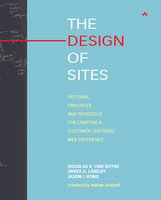Web Usability Books [3]
Today I am continuing my review of Web Usability books, from the perspective (described here) of someone who believes that Performance Matters:
3. The Design of Sites by Douglas K. Van Duyne, James A. Landay and Jason I. Hong
 As its title suggests, this book is written for anyone involved in the design of a Web site. In the preface and on their site the authors say: Its focus is tilted more toward Web design professionals, such as interaction designers, usability engineers, information architects, and visual designers. Since the book comprises over 800 pages of densely-packed design advice, its main audience is pretty clear.
As its title suggests, this book is written for anyone involved in the design of a Web site. In the preface and on their site the authors say: Its focus is tilted more toward Web design professionals, such as interaction designers, usability engineers, information architects, and visual designers. Since the book comprises over 800 pages of densely-packed design advice, its main audience is pretty clear.But the authors claim that it is a resource for anyone on a Web development team, from business executives to advertising managers to software developers to content editors. Its value to this wider audience is well explained by Mike Tarrani in his "spotight" review of the book on Amazon, so I will intersperse Mike's comments below:
Tarrani ... Nearly every book on user interface and site design I've read is aimed at the professional designer who understands the nuances of color, fonts and graphics elements, as well as aesthetics in general. Many of the subtle points are lost on the non professional.The first 100 pages (Part I) are devoted to Foundations of Web Site Design, and include chapters on Knowing Your Customers, Involving Customers with Iterative Design, and the Site Development Process. The authors describe the last of these as ... a rough guide to designing, implementing, and maintaining a Web site. I concur -- it is a useful summary of the major stages, but no more than that. The real meat of the book is Part II, which comprises 517 pages. Here, 91 Design Patterns are organized into 12 pattern groups (A-L), and illustrated with examples of real Web sites.
Tarrani ... It leads you through each example, showing you how a particular design or design concept works and why. This is akin to the Rosetta Stone for the non-professional designer because the authors do not assume any talent of skills in design, and subtle points are highlighted and clearly explained. Because of this approach I finally understood concepts that had eluded me in the past.Not everyone agrees, of course. If you study the Amazon reviews, you'll find a few that rate the patterns as shallow, incomplete, or out-dated. But that is inevitable given the authors' approach -- a book like this can never be complete or up-to-date, because the technology and people's use of it is a continually moving target. In fact, the authors state this in their introduction to Part II. In my view, they made a valiant attempt to classify important Web design patterns, and the great majority of reviewers do find a lot of value in the result.
In addition to the clear explanations that distill design into patterns, the book is lavishly illustrated, using copious full color examples and a structured format that gives the background, frames the problem and provides a solution to each of the 12 design goals.
Tarrani ... Material in the appendices is also invaluable, including advice on running usability evaluation, and associated plan outlines and forms. For a development group this is an extra bonus that will make it easier to incorporate the principles in this book into a quality process that gives customer-focused usability the same weight as technical quality criteria.My own special interest in Performance Matters is served by the last pattern group, Speeding Up Your Site, which comprises five patterns: Low Numbers of Files, Fast Downloading Images, Separate Tables, HTML Power, Reusable Images. While these are not original or surprising, they certainly do address some of the most common page design problems that can affect performance.
I'm so enthusiastic about this book that I've recommended to the company for which I work that a copy of this book be provided to each of our developers who are programming wizards, but who stumble when it comes to the user interface.
[Next book review: Usability For The Web ...]


0 Comments:
Post a Comment